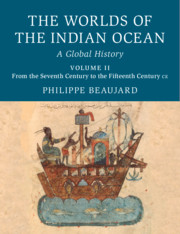Book contents
- The Worlds of the Indian Ocean
- The Worlds of the Indian Ocean
- The Worlds of the Indian Ocean
- Copyright page
- Dedication
- Contents
- Maps and Charts (in Color Plates)
- Illustrations (in Color Plates)
- Figures
- Tables
- Abbreviations
- Part I The Indian Ocean between Tang China and the Muslim Empire (Seventh–Tenth Century)
- Part II Globalization during the Song and Mongol Periods (Tenth–Fourteenth Century), and the Downturn of the Fourteenth Century
- Part III From the Globalization of the Afro-Eurasian Area to the Dawn of European Expansion (Fifteenth and Early Sixteenth Centuries)
- Introduction
- Chapter 14 Ming China: From Expansion to Withdrawal into Threatened Territory
- Chapter 15 India: The Flowering of the Sultanates and the Expansion of Vijayanāgara
- Chapter 16 Southeast Asia: Era of the Merchant Sultanates
- Chapter 17 Western Asia: Revival of the Persian Gulf
- Chapter 18 Egypt and Yemen: Advances in State Trade and the End of the Kārimī
- Chapter 19 East Africa and the Comoros
- Chapter 20 Madagascar (Fifteenth–Sixteenth Century): The Rise of Trading Ports and Development of the Highlands
- Chapter 21 The Portuguese in the Indian Ocean
- Epilogue
- Bibliography
- Index of Geographical Names
- Name Index
- Subject Index
Chapter 17 - Western Asia: Revival of the Persian Gulf
from Part III - From the Globalization of the Afro-Eurasian Area to the Dawn of European Expansion (Fifteenth and Early Sixteenth Centuries)
Published online by Cambridge University Press: 14 October 2019
- The Worlds of the Indian Ocean
- The Worlds of the Indian Ocean
- The Worlds of the Indian Ocean
- Copyright page
- Dedication
- Contents
- Maps and Charts (in Color Plates)
- Illustrations (in Color Plates)
- Figures
- Tables
- Abbreviations
- Part I The Indian Ocean between Tang China and the Muslim Empire (Seventh–Tenth Century)
- Part II Globalization during the Song and Mongol Periods (Tenth–Fourteenth Century), and the Downturn of the Fourteenth Century
- Part III From the Globalization of the Afro-Eurasian Area to the Dawn of European Expansion (Fifteenth and Early Sixteenth Centuries)
- Introduction
- Chapter 14 Ming China: From Expansion to Withdrawal into Threatened Territory
- Chapter 15 India: The Flowering of the Sultanates and the Expansion of Vijayanāgara
- Chapter 16 Southeast Asia: Era of the Merchant Sultanates
- Chapter 17 Western Asia: Revival of the Persian Gulf
- Chapter 18 Egypt and Yemen: Advances in State Trade and the End of the Kārimī
- Chapter 19 East Africa and the Comoros
- Chapter 20 Madagascar (Fifteenth–Sixteenth Century): The Rise of Trading Ports and Development of the Highlands
- Chapter 21 The Portuguese in the Indian Ocean
- Epilogue
- Bibliography
- Index of Geographical Names
- Name Index
- Subject Index
Summary
Weakened by the devastating invasions of Tamerlane’s armies, Mesopotamia and western Iran experienced a checkered history during the fifteenth century. In a state of demographic stagnation or downturn, the region was an easy prey for nomadic Turkmen. The Turkmen, however, never managed to build strong states, owing to a lack of sedentary populations (Martinez-Gros 2009: 643). When Tamerlane died in 1405, the Jalāyerid sultan, Ahmad, who had fled Iraq, came back to Baghdad. Five years later, he died in Tabriz (1410) in a battle led against the Kara Koyunlu Turkmen (“[Those of the] Black Sheep”), who took Baghdad in 1412. Their strongest ruler, Jahan Shāh (1430–1467), controlled Iraq, Fars, and Oman. Tabriz, which was taken in 1406, was the capital of the empire.
- Type
- Chapter
- Information
- The Worlds of the Indian OceanA Global History, pp. 515 - 521Publisher: Cambridge University PressPrint publication year: 2019

